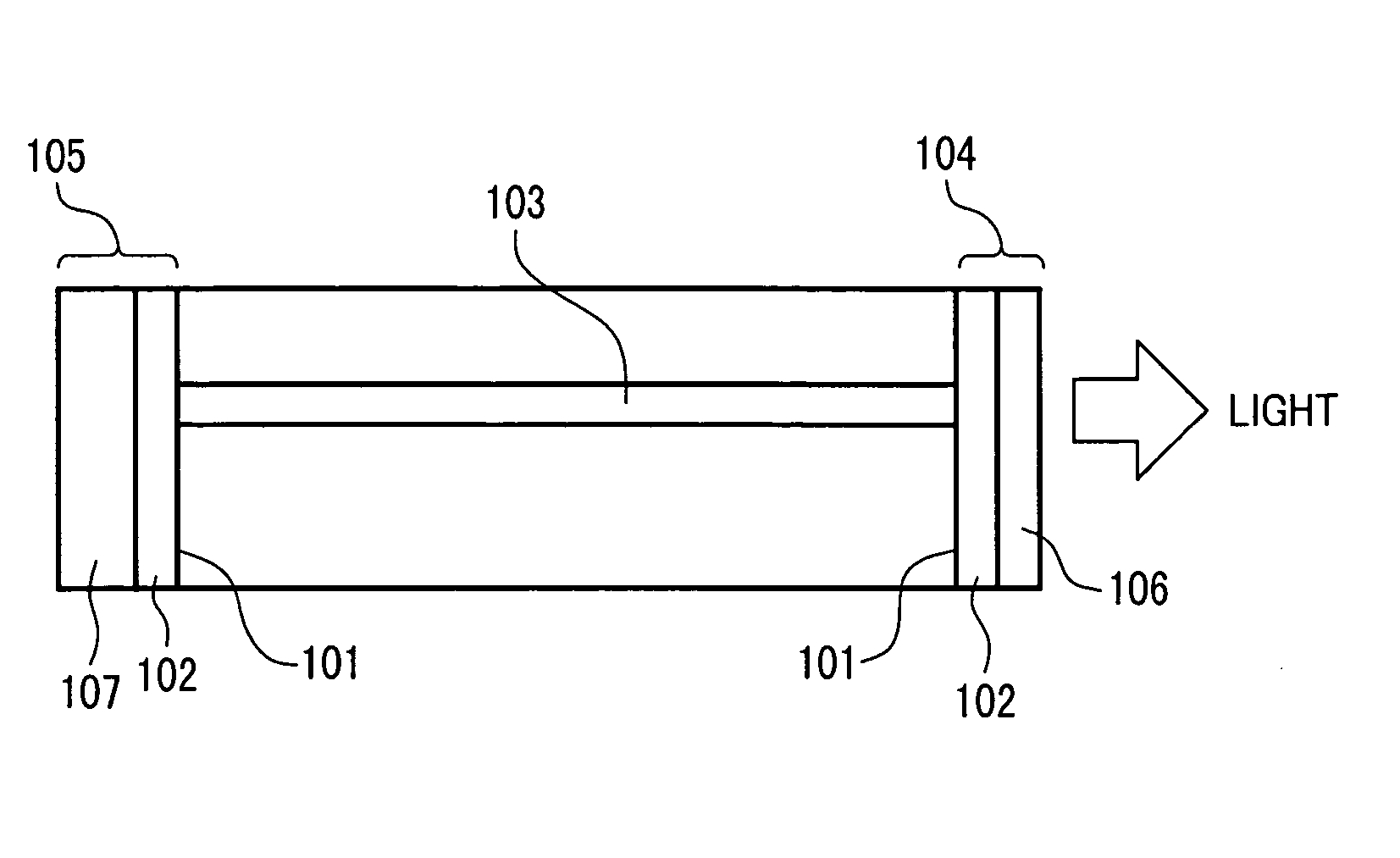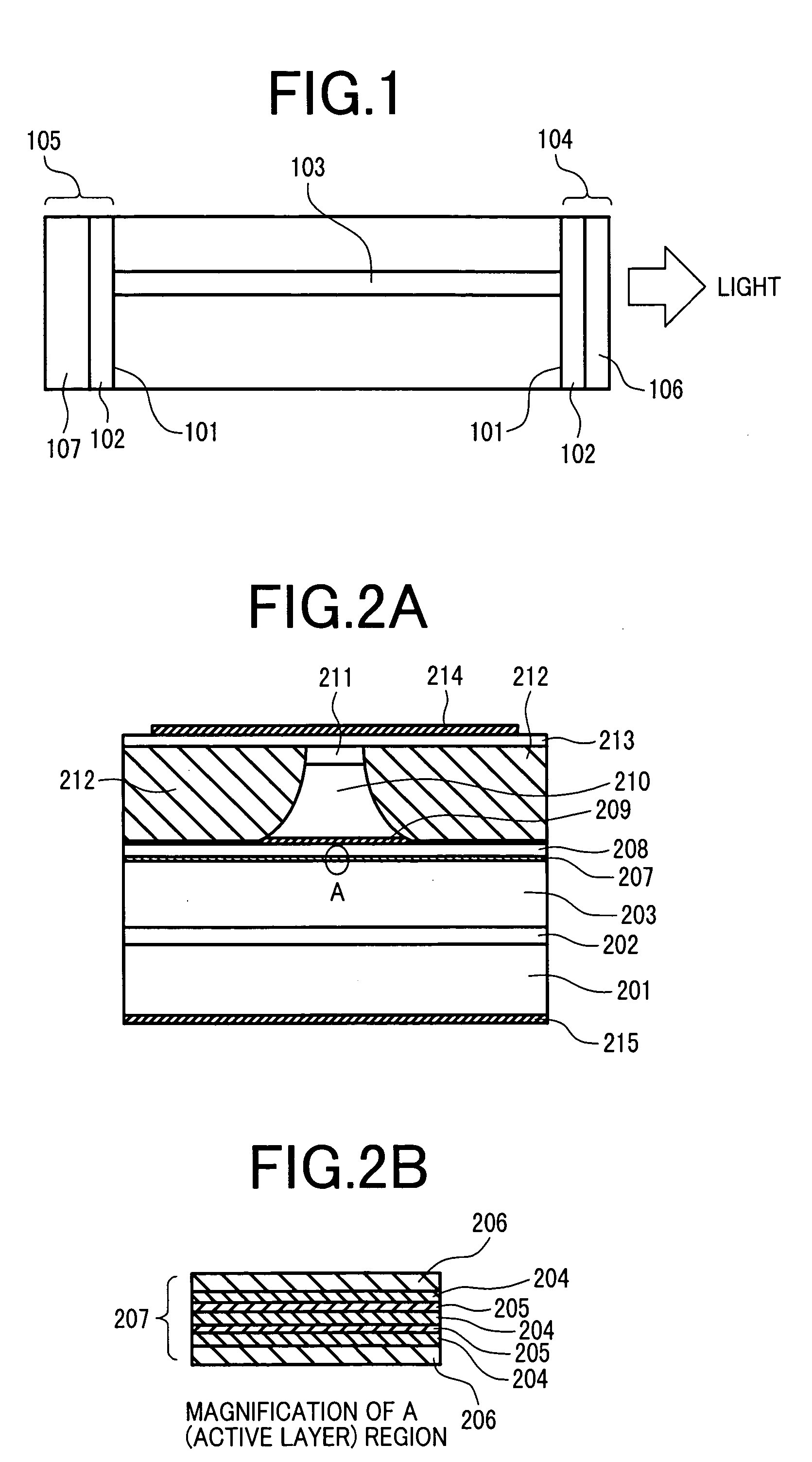Laser diode and manufacturing method thereof
- Summary
- Abstract
- Description
- Claims
- Application Information
AI Technical Summary
Benefits of technology
Problems solved by technology
Method used
Image
Examples
example 1
[0038] A first example of the invention is to be explained with reference to FIGS. 2A, 2B and 3. This example is applied to a high power laser diode for 0.65 μm band used for writing in optical disks or magneto-optical disks. FIG. 2A shows a cross-sectional structure, FIG. 2B is an enlarged view of an active layer, and FIG. 3 shows planer structure. Then a device manufacturing method is to be described. On an n-typed GaAs substrate 201, are formed successively, a GaAs buffer layer 202, an n-typed (AlxGa1-x)InP clad layer 203 lattice matched to GaAs (x=0.7), a strained quantum well active layer 207 comprising (AlyGa1-y)InP barrier layers (y=0.45, barrier layer thickness 4 nm) 204 lattice matched to GaAs, InzGa1-zP strained quantum well layers (z ˜0.58, well layer thickness 87 nm) 205, and (AlsGa1-s)Inp SCH (Separate Confinement Heterostructure) layers (s=0.55, barrier wall layer thickness 4 nm) 206, a p-typed (AltGa1-t)InP clad layer (t=0.7) 208 lattice matched to GaAs, a p-typed InG...
example 2
[0041] A second example of the invention is to be described with reference to FIGS. 4, 5A and 5B. In this example, the invention is applied to a high power laser diode for 0.98 μm band for a rare earth-doped optical fiber amplifier excitation for use in relays or receivers in optical transmitting systems. FIG. 4 shows a planar structure of a laser diode having a Fabry-Pelot type optical resonator, FIG. 5A shows a cross-sectional structure of the same and FIG. 5B shows an enlarged view of an active layer. Then, a device manufacturing method is to be described. On an n-typed GaAs substrate 501, are formed successively, a GaAs buffer layer 502, an n-typed InGaP clad layer 503 latticed matched to GaAs, a strained quantum well active layer 506 comprising In1-xGaxAsyP1-y barrier layers (x=0.82, y=0.63, a barrier layer thickness 35 nm) 504 lattice matched to GaAs, and an InxGa1-zAs strained quantum well layer (z 0.16, well layer thickness 7 mm) 505, a p-typed InGaP clad layer 507 lattice m...
example 3
[0043] A third example applying the invention is to be explained with reference to FIGS. 6 and 7. In this example, the invention is applied to a laser diode for 1.3 μm band used as a light source in subscriber's optical transmission systems. FIG. 6 is a perspective structure of a laser diode and FIG. 7 shows a cross sectional structure. Then, a device manufacturing method is to be described. After growing an n-typed InP buffer layer 702 on an n-typed InP substrate 601, 701, an n-typed InAlAs clad layer 703 lattice matched to InP, an n-typed InGaAlAs lower SCH layer 704, a strained quantum well active layer 705 comprising an InGaAlAs strained barrier layer (band gap: 1.32 eV, barrier layer thickness: 8 nm) and an InGaAlAs strained quantum well layer. (band gap: 0.87 eV, well layer thickness: 6 nm), a p-typed InGaAlAs upper SCH layer 706 lattice matched to the InP substrate, a p-typed InAlAs first clad layer 707, a p-typed InP second clad layer 708, a p-typed InGaAs cap layer 709, and...
PUM
 Login to View More
Login to View More Abstract
Description
Claims
Application Information
 Login to View More
Login to View More - R&D
- Intellectual Property
- Life Sciences
- Materials
- Tech Scout
- Unparalleled Data Quality
- Higher Quality Content
- 60% Fewer Hallucinations
Browse by: Latest US Patents, China's latest patents, Technical Efficacy Thesaurus, Application Domain, Technology Topic, Popular Technical Reports.
© 2025 PatSnap. All rights reserved.Legal|Privacy policy|Modern Slavery Act Transparency Statement|Sitemap|About US| Contact US: help@patsnap.com



